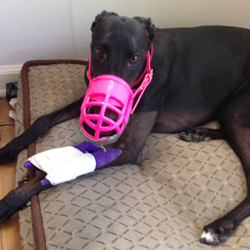GREYHOUND CARE: Hot Weather Danger

Cars, Hot Weather and Your Greyhound
The following information, taken from studies on heat in cars, could save your Greyhound’s life. As the thermometer climbs, it becomes even more critical that you understand and act on this info.
The temperature inside a car will rise approximately 19 degrees in 10 minutes.
A recent study showed that when the outside temperature was 80 degrees, the inside temperature could reach 99 degrees in 10 minutes. Opening windows had little effect.
Davis Instruments in Hayward, California, found even more drastic temperature rises and posted the following report by Jan Null, a retired National Weather Service meteorologist, an adjunct professor of Meteorology at San Francisco State University's Department of Geosciences, and a Certified Consulting Meteorologist with Golden Gate Weather Services:
Another study, this one from the Department of Geosciences at San Francisco State University, found that shortwave radiation further adds heat to the inside of a vehicle by warming objects it strikes. For example, a dark dashboard can reach 180 degrees in a matter of minutes. These objects heat the adjacent air by conduction and convection and also give off longwave radiation which is very efficient at warming the air trapped inside a vehicle.
Dogs are designed to conserve heat. Their sweat glands, found on their noses and the pads of their feet, are inadequate for cooling during hot days. Panting and drinking water helps cool them, but if they only have overheated air to breathe dogs can suffer brain and organ damage after just 15 minutes. Young dogs, seniors, or pets with weight, respiratory, cardiovascular, or other health problems are especially susceptible to heat-related stress.
How often have you dashed into a store to “pick up just one or two items,” and been delayed by seeing someone you knew or encountering a slow sales clerk. On these warm days, don’t leave your Greyhound in the car--even for a minute.
The following information, taken from studies on heat in cars, could save your Greyhound’s life. As the thermometer climbs, it becomes even more critical that you understand and act on this info.
The temperature inside a car will rise approximately 19 degrees in 10 minutes.
A recent study showed that when the outside temperature was 80 degrees, the inside temperature could reach 99 degrees in 10 minutes. Opening windows had little effect.
Davis Instruments in Hayward, California, found even more drastic temperature rises and posted the following report by Jan Null, a retired National Weather Service meteorologist, an adjunct professor of Meteorology at San Francisco State University's Department of Geosciences, and a Certified Consulting Meteorologist with Golden Gate Weather Services:
- “Finding: On a day when the outside temperature was 73° Fahrenheit, it took only 20 minutes for the temperature sensor inside the car to reach a lethal level of 107° Fahrenheit.
- “Finding: On a day when the outside temperature was 86° Fahrenheit, it took only five minutes for the temperature sensor inside the car … to reach 132° Fahrenheit.
- “Finding: On a day when the outside temperature was 86° Fahrenheit, it took only 10 minutes for the temperature sensor inside the vehicle in the shade to reach a lethal level of 109° Fahrenheit.”
Another study, this one from the Department of Geosciences at San Francisco State University, found that shortwave radiation further adds heat to the inside of a vehicle by warming objects it strikes. For example, a dark dashboard can reach 180 degrees in a matter of minutes. These objects heat the adjacent air by conduction and convection and also give off longwave radiation which is very efficient at warming the air trapped inside a vehicle.
Dogs are designed to conserve heat. Their sweat glands, found on their noses and the pads of their feet, are inadequate for cooling during hot days. Panting and drinking water helps cool them, but if they only have overheated air to breathe dogs can suffer brain and organ damage after just 15 minutes. Young dogs, seniors, or pets with weight, respiratory, cardiovascular, or other health problems are especially susceptible to heat-related stress.
How often have you dashed into a store to “pick up just one or two items,” and been delayed by seeing someone you knew or encountering a slow sales clerk. On these warm days, don’t leave your Greyhound in the car--even for a minute.

Hot pavement and burnt feet
This can be a big and very painful hazard. Black top or even grey concrete is almost always too hot for these tender footed hounds during the mid-day. Always test the pavement temperature with your hand if in doubt. If traveling in hot areas bring a rug or quilt to put on the ground for your dogs to stand on when loading and unloading them.
Rattlesnakes
Spring and summer in southern CA brings out the snakes. They like to sun themselves on the trails or may be hiding in the brush or in rock formations. Greyhounds are not snake savvy so please be careful when out walking on trails or in brush. Greys are naturally curious and not so “street smart” when it comes to snakes. With a greyhound’s fast metabolism a snake bit could turn deadly quickly. The best snake protection is to be aware and keep out of their turf! If you greyhound gets bit get to the vet ASAP!! See our vaccination section on rattlesnake vaccination where it states that U.C. Davis Veterinary School (ranked #1 vet school for 2015), does not recommend the Rattlesnake Vaccine, saying this: “injection of the rattlesnake vaccine is not currently advocated by the hospital…it is not recommended by the hospital due to its questionable efficacy, cost, and no substantial difference in acute therapy if bitten.”
This can be a big and very painful hazard. Black top or even grey concrete is almost always too hot for these tender footed hounds during the mid-day. Always test the pavement temperature with your hand if in doubt. If traveling in hot areas bring a rug or quilt to put on the ground for your dogs to stand on when loading and unloading them.
Rattlesnakes
Spring and summer in southern CA brings out the snakes. They like to sun themselves on the trails or may be hiding in the brush or in rock formations. Greyhounds are not snake savvy so please be careful when out walking on trails or in brush. Greys are naturally curious and not so “street smart” when it comes to snakes. With a greyhound’s fast metabolism a snake bit could turn deadly quickly. The best snake protection is to be aware and keep out of their turf! If you greyhound gets bit get to the vet ASAP!! See our vaccination section on rattlesnake vaccination where it states that U.C. Davis Veterinary School (ranked #1 vet school for 2015), does not recommend the Rattlesnake Vaccine, saying this: “injection of the rattlesnake vaccine is not currently advocated by the hospital…it is not recommended by the hospital due to its questionable efficacy, cost, and no substantial difference in acute therapy if bitten.”
This section includes short articles on topics on how to care for your greyhound. Many of the articles came from prior newsletters or were written to address problems or as answer specific questions as they arose. This section will be added to over time as issues come up and/or if new information becomes available. If you have a topic you would like addressed in this section contact us!













